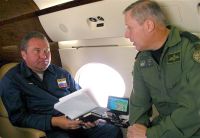ANCHORAGE, Alaska, Aug. 10, 2010 — An automated female voice commands over onboard speakers, “Traffic! Traffic! Descend! Descend!” as a North American Aerospace Defense Command F‑22 fighter approaches the right wing of the track of interest.
Five minutes after take-off from Anchorage en route to the Far East, Fencing 1220 — a Gulfstream 4 simulating a Boeing 757 commercial jetliner — squawked an emergency to ground controllers, spurring action from the Federal Aviation Administration and the Defense Department and kicking off exercise Vigilant Eagle, the first joint counter air-terrorism exercise between NORAD and the Russian air force.
“What we are practicing today is communication procedures between NORAD, plus U.S. civilian air traffic control agencies and our Russian counterparts so that we can pass on information to them about air terrorism events to allow them to posture their forces to respond in kind,” said Canadian Forces Col. Todd Balfe, Alaska NORAD Region deputy commander.
Once the FAA was notified of the trouble on Fencing 1220, they requested assistance from NORAD, which assigned an E‑3 Sentry airborne warning and control platform to the track of interest and diverted two F‑22 fighters to intercept, Balfe said. Because of the aircraft’s planned route, which would take it over Russian airspace, it was necessary to notify Russian air traffic controllers and the Russian military.
At a predetermined location halfway across the Pacific Ocean, the NORAD E‑3, in direct communication with its Russian equivalent, an A‑50 Mainstay, handed over control. Moments later, a deep Russian baritone bellowed, “Fencing One-Two-Two-Zero,” over the aircraft’s radio, and two SU-27 Russian fighters joined the pursuit close enough to see the sun reflecting off the pilot’s visor.
The feeling on board Fencing 1220 was one of collective awe as former Cold War opponents witnessed the fruit of years of planning and joint effort, but the scenario has all too real implications.
“This exercise is very beneficial to North America and to Russia,” said Col. Alexander Vasilyev, deputy director of security and safety for the Russian air force. “There has never been an exercise like this before.
“Terrorism is something that affects all our countries,” he continued, “so it is very important that we work together to develop procedures and bring the relationship between our countries closer together to unite our countries in the fight against terrorism.”
Back in Alaska, members of the 176th Air Control Squadron worked with Russian officers as exercise controllers, making sure all the appropriate processes and procedures were carried out.
Air Force Master Sgt. Doug Patchin, 176th ACS, said he believes Vigilant Eagle is a ground-breaking event that could be emulated by other commands. “This exercise is phenomenal,” he said. “The hope is that everyone walks away from the exercise with a common understanding of what communication procedures would be used in a real-world crisis.”
Balfe described Vigilant Eagle as a momentous exercise and a watershed event.
“We are trying to transition our relationships militarily from a period of confrontation in the Cold War to a period of cooperation, and there is no better mission for NORAD to partner with our Russian counterparts than on the air terrorism mission,” he said. “Regardless of other geopolitical events, we all agree that air terrorism is something we want to prevent, deter and, if necessary, defeat.”
After six hours of tracking by ground controllers in the United States and Russia and aerial surveillance by U.S. and Russian airborne warning and control platforms and fighter aircraft, Fencing 1220 safely landed in the Far East to be handed over to authorities.
After an overnight rest, the exercise was conducted in reverse, allowing Russian forces to turn over responsibility to NORAD and bring Vigilant Eagle 2010 to a successful completion, Balfe said.
“We’ve worked hard on both sides to make this work, and I think it would be logical for this exercise to be a building block for future cooperation between our nations,” Balfe said. “We are building this relationship stronger, which has a real benefit to U.S. and Canadian citizens and obviously Russian citizens too.”
Source:
North American Aerospace Defense Command
U.S. Department of Defense
Office of the Assistant Secretary of Defense (Public Affairs)

 von
von 